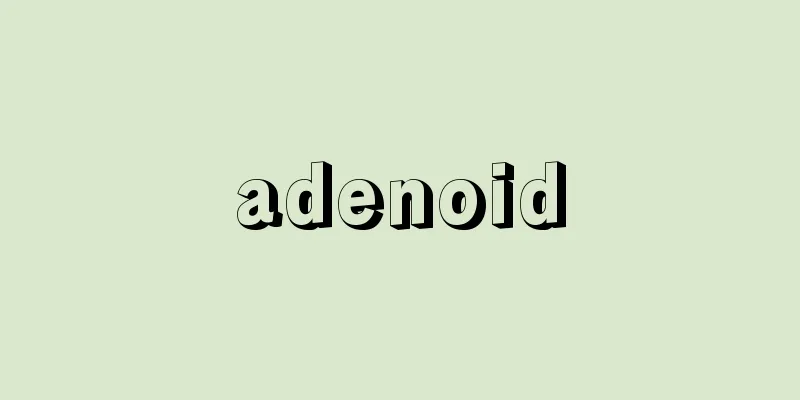adenoid

|
What kind of disease is it? ●Main symptoms and progression Tonsils are lymphatic tissues involved in the immune system, such as fighting pathogens that enter through the nose and mouth. Although they are commonly called "tonsils," this is not a correct name because tonsils do not have glandular tissue. There are several types of tonsils, but the two that cause problems with hypertrophy are the pharyngeal tonsils and the palatine tonsils. The pharyngeal tonsils are located at the back of the nasal cavity, above the uvula. A disease in which the tissue in this area grows and hypertrophies is called adenoids. The palatine tonsils are located on both sides of the uvula, and this is what the term tonsils generally refers to. Abnormal growth and enlargement of the palatine tonsils is called tonsillar hypertrophy. If it is simply enlarged, no treatment is necessary, but if you experience the following symptoms, some form of treatment is necessary. 1. Enlarged pharyngeal tonsils make it difficult to breathe through the nose, causing a heavy head and a lack of concentration. ② Constant mouth breathing causes the lower lip to droop, the facial muscles to relax, and a lifeless expression is observed. 3) Serous otitis media and chronic sinusitis persist and become more difficult to cure. ④Obstruction of the upper airway causes sleep apnea and loud snoring. Difficulty swallowing food or loss of appetite. ⑥ The tonsils are prone to inflammation, causing repeated fevers and sore throats. And more. ● Causes of the disease and how symptoms develop Both the pharyngeal tonsils and the palatine tonsils develop shortly after birth, with the pharyngeal tonsils reaching their largest size around 3 to 5 years of age and the palatine tonsils reaching their largest size around 5 to 7 years of age, and then shrinking as the immune system develops. Hypertrophy itself is a natural physiological phenomenon and is not a pathological condition. Treatment is only indicated if various symptoms appear. EBM checks on common treatments and care [Treatment and care] If there are no problematic symptoms, no special treatment is necessary. [Evaluation] ☆☆ [Evaluation points] The condition will progress well even if left untreated, and there are no symptoms or complications, so there is no need for treatment. ■ Consider surgery [Treatment and care] If upper airway obstruction is present [Rating] ☆☆☆ [Evaluation Points] Surgery is required. Clinical studies have confirmed that it is effective for sleep apnea symptoms. (1) [Treatment and care] If serous otitis media persists or recurs [Rating] ☆☆ [Evaluation Points] Reliable clinical studies have confirmed that after surgery, the frequency of serous otitis media is lower than without surgery, but the difference is very small. Considering complications from surgery, recurring serous otitis media alone does not necessarily require surgery. (2)(3) [Treatment and care] If fever or pharyngitis recurs [Rating] ☆☆ [Evaluation points] Reliable clinical studies have confirmed that the frequency of pharyngitis decreases after surgery, but the difference is very small. Considering complications from surgery, it is not necessarily necessary to undergo surgery just because pharyngitis recurs. (4)-(6) No drug therapy Overall, it is currently the most reliable treatment <br /> Hypertrophy itself is a natural physiological phenomenon Tonsils are lymphatic tissues involved in the immune system, fighting against pathogens that enter through the nose and mouth. Adenoids are the proliferation and enlargement of the pharyngeal tonsils located at the back of the nasal cavity and above the uvula. Tonsillar hypertrophy is the abnormal proliferation and enlargement of the palatine tonsils located on both sides of the uvula, commonly known as tonsils. Both the pharyngeal tonsils and the palatine tonsils develop shortly after birth, with the pharyngeal tonsils reaching their maximum size around 3-5 years of age and the palatine tonsils reaching their maximum size around 5-7 years of age, and then decreasing in size. Therefore, hypertrophy itself is a physiologically natural phenomenon and is not a pathological condition. Treatment is required only if various symptoms appear. Surgery is only considered if there are obvious complications that are causing distress to the patient, such as recurring fever or sore throat, persistent or recurring otitis media with effusion, or difficulty breathing. It is true that highly reliable clinical studies have shown that surgery reduces the incidence of pharyngitis and serous otitis media, but the difference compared to not performing surgery is very small. Therefore, considering the possible complications that may occur from surgery, surgery is not necessarily necessary. It is important to carefully consider how painful the symptoms are for the patient. Unless there is an obvious infection, frequent use of antibiotics for adenoid/tonsillar hypertrophy itself is not recommended. (1)Randerath WJ, Verbraecken J, Andreas S, et al. Non-CPAP therapies in obstructive sleep apnoea. Eur Respir J. 2011; 37:1000. Source: "EBM: A book that explains correct treatment" Information about the book "EBM: A book that explains correct treatment" |
|
どんな病気でしょうか? ●おもな症状と経過 扁桃(へんとう)は鼻や口から侵入する病原体と戦うなど、免疫にかかわっているリンパ組織です。一般に「扁桃腺(へんとうせん)」と呼ばれますが、扁桃には腺組織がないので正しい呼び方ではありません。 扁桃にはいくつかの組織がありますが、増殖肥大が問題となるのは、咽頭扁桃(いんとうへんとう)と口蓋扁桃(こうがいへんとう)の二つです。咽頭扁桃は鼻腔(びくう)の奥、口蓋垂(こうがいすい)(のどちんこ)の上のほうにあります。この部分の組織が増殖肥大する病気をアデノイドといいます。 口蓋扁桃は口蓋垂の両側にあるもので、一般に扁桃といえばこの部分を指します。口蓋扁桃が異常に増殖肥大したものを扁桃肥大と呼んでいます。 単に肥大しているだけであれば、治療の必要はありませんが、次のような症状がみられたら、なんらかの治療が必要になります。 ①咽頭扁桃が肥大するために鼻での呼吸が困難になり、頭が重くなったり、注意力が散漫になったりする。 ②常時、口呼吸をするために、下唇が下に垂(た)れてきたり、顔面の筋肉がゆるみ、生気のない表情になる。 ③滲出性中耳炎(しんしゅつせいちゅうじえん)や慢性副鼻腔炎(まんせいふくびくうえん)が長引き、治りにくくなる。 ④上気道の閉塞(へいそく)によって、睡眠時に無呼吸や激しいいびきが現れる。 ⑤食べ物の飲み込みが難しくなったり、食欲不振となる。 ⑥扁桃に炎症をおこしやすく、発熱や咽頭痛をくり返す。 などです。 ●病気の原因や症状がおこってくるしくみ 咽頭扁桃も口蓋扁桃も、生後まもなく発達し、咽頭扁桃は3~5歳ごろ、口蓋扁桃は5~7歳ごろにもっとも大きくなり、その後免疫機能が発達すると小さくなっていきます。肥大自体は生理的に自然な現象で、病的な状態ではありません。さまざまな症状がでた場合にだけ治療の対象となります。 よく行われている治療とケアをEBMでチェック [治療とケア]問題となる症状がなければ、とくに治療の必要はない [評価]☆☆ [評価のポイント] 放置しても経過はよく、症状や合併症さえなければ治療の必要はありません。 ■手術を検討する [治療とケア]上気道の閉塞(へいそく)を認める場合 [評価]☆☆☆ [評価のポイント] 手術が必要となります。無呼吸症状に効果を認めることが臨床研究によって確認されています。(1) [治療とケア]滲出性中耳炎が長引いたり、くり返したりする場合 [評価]☆☆ [評価のポイント] 手術を行うと、その後、滲出性中耳炎になる頻度(ひんど)が手術をしない場合よりも少なくなることは信頼性の高い臨床研究によって確認されていますが、その差はほんのわずかです。手術による合併症などを考えると、滲出性中耳炎をくり返すだけでは手術を行う必要は必ずしもないと考えられます。(2)(3) [治療とケア]発熱や咽頭炎をくり返す場合 [評価]☆☆ [評価のポイント] 手術を行うと、その後、咽頭炎になる頻度が減少することは信頼性の高い臨床研究によって確認されていますが、その差はほんのわずかです。手術による合併症等を考えると、咽頭炎をくり返すだけでは手術を行う必要は必ずしもないと考えられます。(4)~(6) 薬物療法はありません 総合的に見て現在もっとも確かな治療法 肥大自体は自然な生理的現象 扁桃は鼻や口から侵入する病原体と戦うなど免疫にかかわっているリンパ組織です。鼻腔の奥、口蓋垂の上のほうにある咽頭扁桃が増殖肥大するのがアデノイドです。一般に扁桃と呼ばれる口蓋垂の両側にある口蓋扁桃が異常に増殖肥大したものが扁桃肥大です。 咽頭扁桃も口蓋扁桃も、生後まもなく発達し、咽頭扁桃は3~5歳ごろ、口蓋扁桃は5~7歳ごろにもっとも大きくなり、その後小さくなっていくため、肥大自体は生理的に自然な現象で、病的な状態ではありません。さまざまな症状がでた場合にだけ治療の対象となります。 つらい症状がある場合のみ手術を検討 発熱や咽頭炎をくり返す、滲出性中耳炎が長引いたりくり返したりする、呼吸するのが難しいなどといった、患者さん自身に苦痛を与える合併症が明らかな場合にのみ、手術が考慮されます。 確かに、咽頭炎の頻度や滲出性中耳炎の頻度が手術によって減少することは非常に信頼性の高い臨床研究によって明らかになっていますが、手術を行わない場合との差はほんのわずかです。 そのため、手術によっておこりうる合併症などを考慮すると、必ずしも手術を行う必要はないと考えられます。患者さんにとって症状がどれだけ苦痛であるかを見極め、慎重に検討するべきでしょう。 明らかな感染症がある場合を除けば、アデノイド/扁桃肥大自体に対して抗菌薬を頻繁に用いるのは勧められません。 (1)Randerath WJ, Verbraecken J, Andreas S, et al. Non-CPAP therapies in obstructive sleep apnoea. Eur Respir J. 2011; 37:1000. 出典 法研「EBM 正しい治療がわかる本」EBM 正しい治療がわかる本について 情報 |
<<: Adenovirus - Adenovirus (English spelling)
Recommend
Nameless - Myonuki
Also called "nukichi." In the late Middl...
Ogma
Danu was the goddess of fertility and wealth, Lug...
Military Arsenal - Gunkosho
A general term for national military factories tha...
"Ezo Diary" - Ezo Nisshi
…From 1833 (Tenpo 4), he traveled throughout Japa...
Friedrich Wilhelm Nietzsche
German poet and philosopher. He is a standard-bea...
Eckhart, WJ
…The lunar calendar based on the new method is ca...
Port of Eunostos - Eunostos Port
...The royal palace, government offices, and acad...
CEA
Reference value 2.5ng/ml or less (RIA method) Or ...
Aleksandrovsky village
...Population: 1,431,000 (1993). It began as the ...
Tupi - Tupi (English spelling)
A general term for the Tupi-speaking groups in So...
Felis concolor coryi (English spelling)
…[Tadaaki Imaizumi]. … *Some of the terminology t...
Konpeito - Konpeito
It is a sugar confectionery among the Nanban swee...
Minister of the Council of Ministers - Yi-zheng-wang Da-chen; I-chêng-wang Ta-chên
A general term for the members of the highest coun...
Arita-Craigie Talks - Arita-Craigie Talks
A meeting was held in Tokyo from July 15th between...
Mamacona - Mamacona
A semi-parasitic annual plant of the Scrophularia...






![Nakanojo [town] - Nakanojo](/upload/images/67cc643469068.webp)


